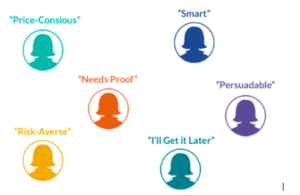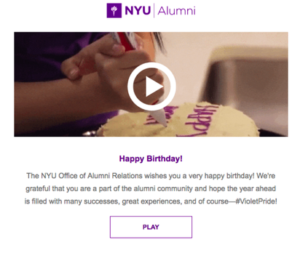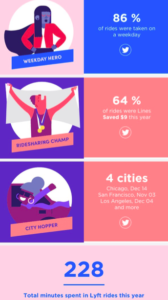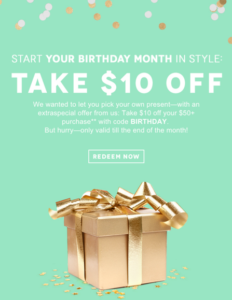5 Ways Personalized Email Content Can Improve Your Customer Retention Rate

If you’re like most e-commerce businesses out there, you likely focus a large percentage of your marketing efforts on generating and converting new leads.
How much could you grow your revenue by changing your focus?
Marketing to an existing customer is 60-70% more effective than selling to a new customer. While 40% of e-commerce revenue is derived from just 8% of repeat customers. As such, customer retention is key to growing your annual profits.
From stepping-up your customer service to fine tuning your user experience, it can be difficult to work out which areas to focus on to improve your customer retention rates. However, research consistently highlights that email marketing is one of the most effective strategies for retaining customers.
64% of businesses crowned email marketing the most efficient way to retain customers. Not only that, but email marketing also offers an impressive ROI – with an average return of $44 for every $1 spent.
One of the best ways to improve customer retention rate with email? Personalization. In this post, we explore four of the best forms of personalized email content for improving your customer retention rate.
H1 Personalize Based on Segmentation

Screenshot from Pointillist.
Most customers are tempted to hit the unsubscribe button if you’re forever sending out content that’s irrelevant to them.
Sending generic emails to your entire customer base is never going to be as impactful as sending targeted emails to specific customer segments.
Your customers are flooded with newsletters, promotional emails, and content from hundreds of different companies each week. In order to reach your customers, you need to provide them with content that’s relevant to them. Delivering targeted content to the right customers, at the right time, is key to customer retention.
Yet, personalizing your emails goes beyond using your customer’s first name. You likely already use several basic forms of personalization in your marketing outreach. Despite your best efforts? You still may be of the hundreds of businesses failing to meet your customers’ expectations for personalization.
Only 22% of shoppers feel that their shopping experience meets their expectation of a highly personalized shopping experience.
In order to bridge the personalization gap, you need to dig deeper into their defining characteristics and preferences to intuit and meet their expectations for personalization. The first step in the process? Segmentation. Segmentation involves grouping your customers based on key characteristics or behaviors.
And segmentation works.
Leading marketing teams report a 760% increase in email-generated revenue from segmented campaigns. Segmentation also inspires your customers to spend more: 49% of shoppers made impulse buys after receiving a personalized recommendation.
Which features should you focus on when segmenting your list? Here are some of the most effective:
- Interests
- Job role
- Location
- Purchase behavior
- Abandoned carts or pages
- Relationship (a new subscriber vs a VIP customer)
- Website engagement
- Email open rates
- Gender
- Psychographics (such as personality traits or spending habits)
Want to see a segment in action? When segmenting your list based on purchase behavior, target customers who have purchased specific products or services in the past month. Next, send them a discount code for a similar or complementary item.
H3 What’s the Best Way to Collect Customer Data?
Get your customers to segment themselves by providing surveys on their preferences when they create an account with you. Known as the self-segmentation email: send them an email with three simple, multiple-choice questions, such as questions on their job or age category.
You don’t have to take a magnifying glass to the trends in purchase behavior. Beyond basic demographic data, such as age, gender, and job title, you can also create more detailed surveys on customer preferences.
If you’re a jewellery brand, you may survey your customers on the style of jewellery they prefer, the pieces they like to wear, and how often they accessorize. Your customers are most likely to fill in surveys right after they purchase something from you. To capture their data, send a short post-purchase questionnaire as soon as they head through checkout.
H2 Make Personalized Recommendations

Source: Oracle.
Using the unique buying behavior of each customer to personalize offers is way more effective than attempting to personalize email content based on questionable predictions on the different interests of different demographics. You can use data on your customer’s previous purchase behavior to recommend relevant products in your email outreach.
If you’re a sneaker wearer, wouldn’t you be more engaged by a company that recommends the latest line of Nike’s in your favourite color, rather than a dress-shoe you’ll never wear?
Personalized recommendations, based on previous purchase behavior, helps customers feel you recognize their individual preferences, and don’t just see them as another faceless customer.
H2 Boost Customer Engagement with Dynamic Forms of Content
From newsletters to personalized coupons, engaging email copy is a great way to strengthen relationships with your existing customers. While almost every business relies on snappy email copy for building customer relationships, not every company is using interactive, dynamic content to drive engagement.
However, including video content in an email can increase your open rate by 19% and increase your click-through rate by 50%. Interactive content, such as a video, is a great way to deliver personalized messages to customers. Take a look at this Birthday email from NYU:

Source: NYU.
H2 Make Your Customer the Protagonist of the Tale
You can also use customer data to create engaging, story-based email content. Evocative email content can be used to tell a story about your customer and making your customer the hero of the tale can have a powerful effect on how loyal they feel towards your brand.
We are neurologically wired to connect with stories. When we hear a story that resonates with us, our brain is pumped full of feel-good oxytocin.
Lyft, the popular rideshare company, is a brilliant example of how to weave personal customer data into a powerful personal story:

Source: Really Good Emails
H2 Magnetize Customers Hooked in by Email with Personalized Landing Pages

Screenshot Half a Bubble Out.
Personalized emails are a tactic every business uses to build relationships with their customers. However, not every business uses personalized landing pages to help move prospects further down their sales funnel.
Segment your customer base, then ask – what kind of message would these customers be most interested in seeing? Matching your email to your landing page builds trust and likeability through brand coherence. This combo also helps strengthen your relationship with your customer base – customers grow to feel their personal needs and desires are addressed consistently by your business across different platforms.
H2 Never Forget a Birthday…

Screenshot from Mail Up.
Anniversary campaigns are a great way to re-engage customers who have somewhat forgotten your brand. Personalized coupons that celebrate a birthday or sign-up-anniversary are also a compelling way to promote brand loyalty by making your customers feel personally valued.
In addition, personalized anniversary coupons are a highly-regarded tactic for driving customer loyalty with 61% of consumers saying they use them.
H2 The Power of the Personalized Email in Customer Retention
As a growing e-commerce business, it’s tempting to pass up customer retention for customer acquisition. But chasing shiny new customers, rather than working on your relationship with existing ones, cuts you off from some of the most profitable sources of revenue for your business.
From utilizing dynamic, interactive content to sending personalized recommendations based on purchasing behavior, personalized email content is one of the quickest routes to improving your customer retention rate.